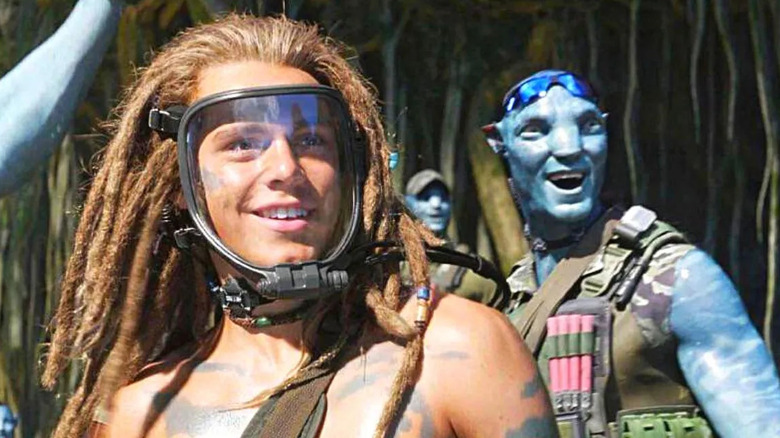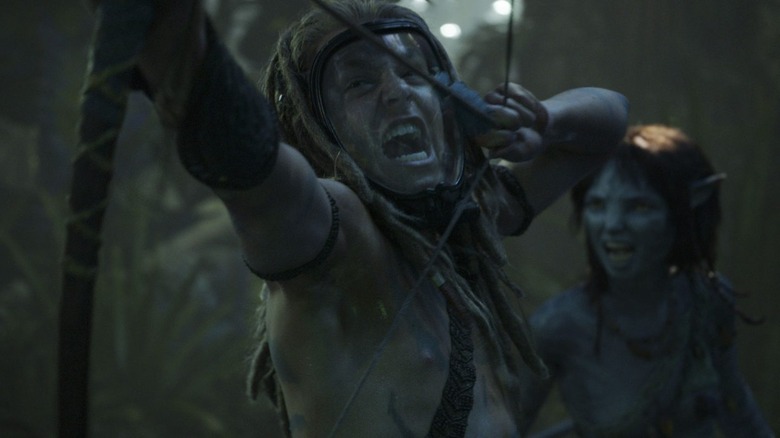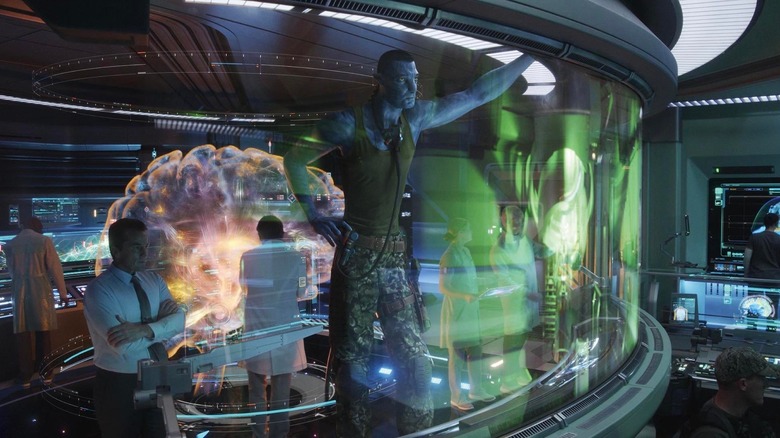One Of Avatar: The Way Of Water's Biggest Technical Achievements Got Its Start In The Sports World
Back in 2001, with the release of Peter Jackson's fantasy film "Lord of the Rings: The Fellowship of the Ring," the filmmakers faced a unique visual challenge. Multiple characters in the film were hobbits, a species of humanoids that stand about three feet, and they had to regularly interact with human characters double their height. Jackson had cast the 5' 6" Elijah Wood as hobbit Frodo Baggins, and had to use several clever techniques to achieve the height disparity between he and the 5' 11" Ian McKellan, playing the wizard Gandalf. Jackson employed forced perspective, and McKellan had to spend a lot of time in an all-green room, acting opposite a tennis ball on a stick. The tennis ball is meant to show an actor where they're meant to be looking so that they appear to be making eye contact once another character is keyed in.
Tall/short character interaction was fun, but not entirely convincing in 2001. Gravity was an issue, and large characters seemed to be able to move just as nimbly as small ones.
In 2009, with the release of James Cameron's "Avatar," a similar issue was present in that the Na'vi characters stood about nine feet tall, and had to occasionally interact with average-height humans. Cameron, more so than Jackson, was able to utilize new kinds of motion-capture technology to make the human/alien interactions look a lot more natural. When Jackson returned to hobbits in 2013 with "The Hobbit: An Unexpected Journey," filmmaking tech had improved — he also shot his film in a high framerate — so that size disparity was almost ... almost ... no longer an issue.
And a camera system you've seen utilized at sporting events helped push the tech along.
Capturing eyelines
With the release of "Avatar: The Way of Water," such differentials have been smoothed over even more using a specific kind of camera scanning tech that had been pioneered for sporting events. In a recent press conference (attended by /Film) with the technicians at New Zealand's preeminent SFX studio Wētā, the visual effects experts explained the way the animation was used. Dan Barrett was the senior animation supervisor on "Water," Richie Baneham was the VFX supervisor for an additional VFX house Lightstorm, and Jon Landau was the film's producer. Together, they talked about how their work was cut out for them. Landau said that "comparing this movie to the first movie, we had a lot more human/CG interaction with one another," and entreated the technicians to elucidate. Barrett said:
"The first film was really hard. It was really, really hard. This one came along and it became ten times harder [...] The first film we had small scenes, scenes with only a couple pf people. But now, we're doing these really closely coupled CG characters and human characters — Quaritch and Edie Falco is a really good example of that — and everything has to be bang on. It's not just the eyelines, it's not just the lighting. It's the fact that the two actors, the two performers, you have to believe that they are actually seeing each other."
Baneham also points out that it wasn't just a matter of eyelines because "Water" was also shot in 3-D. Getting a clear eyeline is going to be especially difficult using stereoscopic cameras that are recording a 3-D plane.
Spider
Landau then talked about the tennis ball phenomenon, and got into the nitty-gritty of a cable camera system that they had to use to achieve those interactions, sans tennis balls ... and sans cameras. Cable cameras are likely familiar to people who have seen football games. Using a complex system of wire pulleys, a camera is suspended over a sporting event, and it is able to, at a moment's notice, capture just about any angle of the field. It provides a similar effect as a drone, but steadier and without helicopter blades.
Landau explained that the team used cable cam systems to eliminate artificial eyeline recreations by assigning a floating machine to recreate motion-capture performance, already saved into the film's computer systems. He uses an example of the Na'Vi Quaritch (Stephen Lang) interrogating the human Spider in a holding cell:
"What we did was we took this system, and instead of putting a camera on it, we put a monitor and a speaker that was playing back a performance. Then we programmed this cable cam system to match the movement of the performance that was captured from the actor. For example, our fist day of filming live-action, Edie Falco has Spider in interrogation, and Quaritch comes up and hits the button and stops him. She was playing to the monitor with Stephen Lang's performance on it! They can see it, and she's following that eyeline."
The team also explained that they built two sets, one to human scale, and a slightly smaller one for the Na'vi performers, allowing them to more comfortably exist in their environment.
A lot of technology can go into making something look as natural as possible. Given how convincing the FX are in "The Way of Water," it seems the team succeeded.


